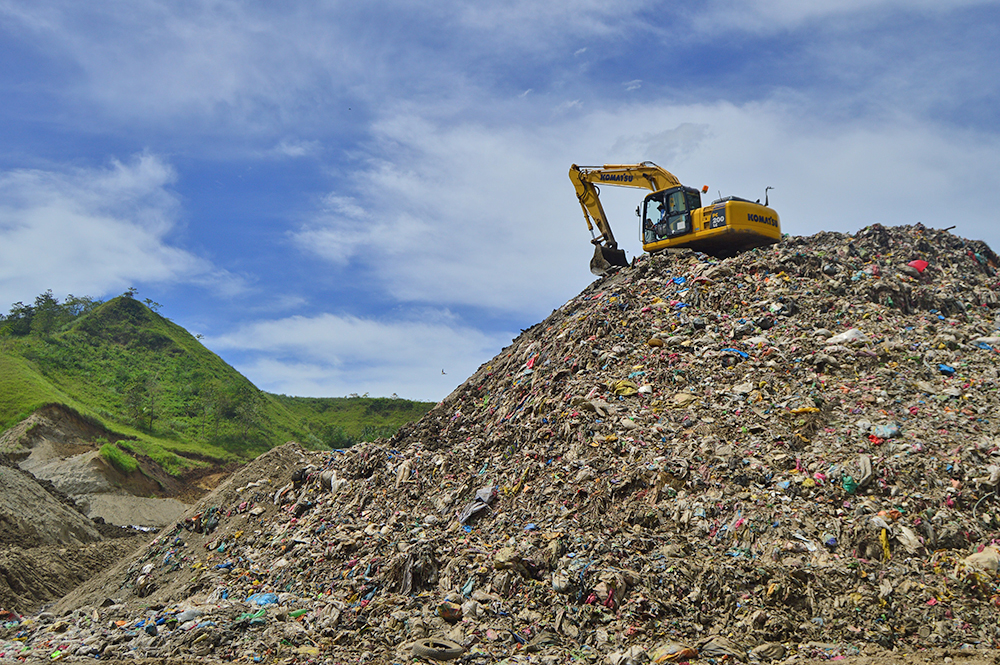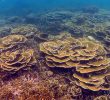
Heavy equipment prepare the piles of garbage before these can be dumped into a “cell” at the sanitary landfill in Sitio Burakan, Barangay Pagalungan, Cagayan de Oro. The sanitary landfill is among the projects initiated by the city government in compliance with the provisions of Republic Act 9003 of the Solid Waste Management Act of 2001. (Jigger J. Jerusalem/davaotoday.com)
CAGAYAN DE ORO CITY – Local environment officials have denied that liquid substance from wastes dumped at the sanitary landfill in Sitio Burakan, Barangay Pagalungan here has contaminated one of the city’s major rivers.
The denial was intended to belie allegation that the seepage caused fish kill and skin illness among residents in a neighboring village.
Solid Waste Management division chief Elvisa Mabelin has maintained that the leachate from the Pagalungan landfill is under control and it’s not the factor that had caused the reported fish kill in Iponan river and alleged cases of skin irritation being experienced by residents in Barangay San Simon.
She said all the liquid from the wastes called “leachate” in the landfill stays in the “cell,” a portion of the landfill where the garbage is dumped and proper intervention is being applied.
A cell, about five meters deep and a hectare wide, can accommodate up to 500,000 cubic meters of trash. A cell has a lifespan of 14 months to two years before it is covered with soil and another cell is constructed. The city generates an average of 800 cubic meters or 235 tons of garbage daily.
The cell’s flooring is covered with lining materials – first with geosynthetic clay liner and then with high-density polyethylene – that prevent any liquid from seeping to the ground or from flowing into the nearby creek. A pipe is installed underneath the cell so the fluids from the wastes go directly to the leachate pond.
If the leachate pond has reached a certain level, it is then pumped back into the cell. This is to ensure that the leachate will not overflow.
The process to control the leachate, Mabelin said, is through “circulation and evaporation.”
She also made it clear that “the rainwater that flows to Iponan river is not contaminated by the leachate” from the landfill.
That’s why, she said, it is not likely that the leachate will contaminate the Iponan river and affect the marine life and the well-being of the people in San Simon.
Besides, she added, the Pagalungan landfill has only been in operation for seven months, so a contamination, if any, is not that “significant.”
She said the environment agencies must conduct further investigation to determine what really caused those problems in San Simon.
Mabelin said the Environment Management Bureau (EMB) in the region has taken water samples from the river and result of the test has yet to be announced.
No effect on Pagalungan folks
Pagalungan village council member Edmund Llusala said that since the landfill started its operation, they have not noticed any adverse effect on the residents.
“The landfill has not affected the health of our constituents. We even advised the people living near the landfill to report to us if they noticed something. But as of now, wala pa,” Llusala said in a separate interview.
In the reported fish kill and ill-effects of the sanitary landfill’s liquid waste, the San Simon council has not shown any evidence that could support their complaint, said Edgardo Naguio, the city’s Solid Waste Management coordinator for district 2.
Naguio said not one killed fish was presented, and no one from San Simon had gone to the health center there to complain of skin illness.
Lifespan
The Pagalungan landfill has total land area of 45 hectares, which is good for 20-30 years, depending on the volume of wastes being dumped there.
The lesser the trash that are brought to the landfill, Mabelin said, the longer that it can be used, which can extend up to 45 years.
She said 67 of the city’s 80 villages are now complying with the waste segregation provision of Republic Act 9003 or the Solid Waste Management Act of 2001, and this practice could reduce the volume of garbage dumped in the landfill by half.
These barangays, she added, have set up their own materials recovery facilities (MRFs) where recyclable garbage such as used bottles and plastics, discarded papers, among others, are collected and sold to junk shops or recycling facilities.
Village residents are also encouraged to gather their biodegradable wastes and dig up compost pits in their neighborhood to further cut the amount to trash being brought to the landfill.
“Once segregation at source is practiced in all 80 barangays and only residual wastes are dumped in the landfill, we can significantly reduce our garbage and prolong the lifespan of our landfill,” Mabelin said.
Ombudsman’s order
It can be recalled that Cagayan de Oro is one of the cities facing charges before the Office of the Ombudsman for failing to comply with RA 9003, prompting the city government to close the 17-hectare dumpsite in Upper Dagong, Barangay Carmen and opening the Pagalungan landfill.
About P100 million from this year’s annual budget was allocated for the sanitary landfill, including the acquisition of the lot, land development, building of facilities, road maintenance, and operational needs.
The old dumpsite, now fully covered with soil and planted with trees, also functions as the city’s centralized MRF.
Part of the rehabilitation plan of the Upper Dagong dumpsite is to convert it into an eco-park once the area has been declared as methane-free. Pipes were installed acting as exhaust for the methane deposits below the ground.
A cooperative composed of former garbage scavengers uses a portion of the dumpsite for its various endeavors. The group also manages the centralized MRF.(davaotoday.com)









